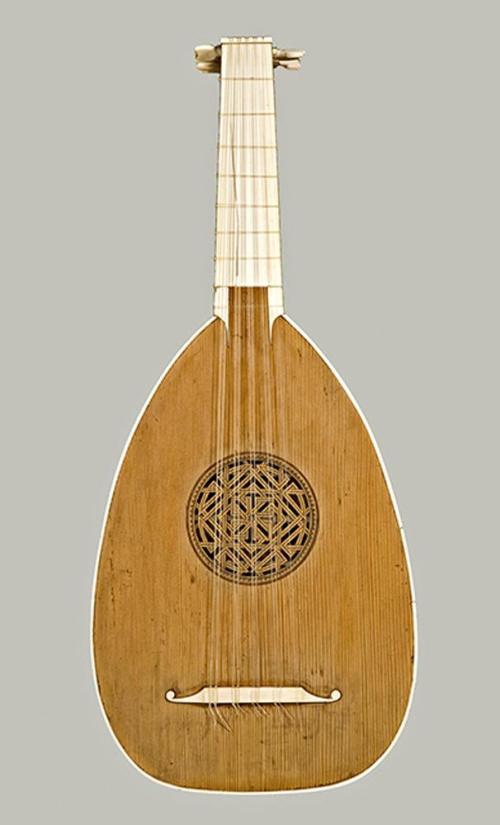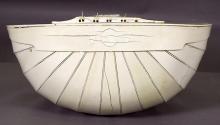Home
>
Works
>
5-course treble lute
>
Advanced Search
Plucked Strings
Lutes
5-course treble lute
Maker: D. G.
Date: 1480-1938 ca.
Place Made:Venice, Italy, Europe
SignedBranded on clasp: D [triangle] G
Branded on top below fingerboard: [triangle in circle] / DG
Branded on top below fingerboard: [triangle in circle] / DG
DescriptionThis ivory lute is of a style seen in Italian iconography of the end of the fifteenth century. A number of instruments, apparently of a set, in this style survive, of varying quality. Included are a number of lutes, a rebec, a lira da braccio, a spinet, a harp, and a tromba marina. The authenticity of these instruments are a subject of disagreement among experts, and it is also possible that some, but not all have earlier components.
A set of these instruments, called "The Angelic Concert" was purchased by the Roman antiquities dealer Giuseppe Sangiorgi from the collection of the late Modena instrument collector Count Luigi Francesco Valdrighi in 1909. The instruments were dispersed to a variety of buyers through the end of the 1930s, and currently instruments of this type can also be found in the Paris museum collection and private collections. It is not clear how many date to Valdrighi's time, or before, or were made to fill out the set under the supervision of Sangiorgi. Hence the possible date range of construction runs over five centuries.
Technical drawing available for purchase.
Stringing: 4 double courses and chanterelle
Soundboard: one-piece fir cut off the quarter: wide grain; wood pin through top into bottom block
Bowl: 13 ivory staves, divided by ivory strips
Clasp: ivory
Head: veneered with ivory
Neck: veneered with ivory
Binding: ivory
Fingerboard: ivory; no radius
Nuts: ivory
Bridge: ivory tie bridge
Tuners: 9 ivory friction pegs with integral pins
Rose: knot pattern carved from wood of top
Lacquer: none
Bowl lining: paper strips with writing in black ink glued at joints between ribs; plain paper strips glued perpendicular to joints
Braces: four softwood braces on inside of top, one above soundhole, one across middle of soundhole, one below soundhole, and one just in front of bridge; four additional strips of softwood reinforcing rose
A set of these instruments, called "The Angelic Concert" was purchased by the Roman antiquities dealer Giuseppe Sangiorgi from the collection of the late Modena instrument collector Count Luigi Francesco Valdrighi in 1909. The instruments were dispersed to a variety of buyers through the end of the 1930s, and currently instruments of this type can also be found in the Paris museum collection and private collections. It is not clear how many date to Valdrighi's time, or before, or were made to fill out the set under the supervision of Sangiorgi. Hence the possible date range of construction runs over five centuries.
Technical drawing available for purchase.
Stringing: 4 double courses and chanterelle
Soundboard: one-piece fir cut off the quarter: wide grain; wood pin through top into bottom block
Bowl: 13 ivory staves, divided by ivory strips
Clasp: ivory
Head: veneered with ivory
Neck: veneered with ivory
Binding: ivory
Fingerboard: ivory; no radius
Nuts: ivory
Bridge: ivory tie bridge
Tuners: 9 ivory friction pegs with integral pins
Rose: knot pattern carved from wood of top
Lacquer: none
Bowl lining: paper strips with writing in black ink glued at joints between ribs; plain paper strips glued perpendicular to joints
Braces: four softwood braces on inside of top, one above soundhole, one across middle of soundhole, one below soundhole, and one just in front of bridge; four additional strips of softwood reinforcing rose
DimensionsTotal treble lute length: 606 mm
Top length: 373.5 mm
Maximum body width: 257 mm
Maximum bowl height: 116 mm
Head length: 162.9 mm
Head width, top: 30.5 mm
Head width, bottom: 40 mm
Neck length (nut to ribs): 210 mm
Neck width, nut: 39 mm
Neck width, heel: 50 mm
Soundhole diameter: 91 mm
Vibrating string length (nut to bridge edge): 500 mm
Top length: 373.5 mm
Maximum body width: 257 mm
Maximum bowl height: 116 mm
Head length: 162.9 mm
Head width, top: 30.5 mm
Head width, bottom: 40 mm
Neck length (nut to ribs): 210 mm
Neck width, nut: 39 mm
Neck width, heel: 50 mm
Soundhole diameter: 91 mm
Vibrating string length (nut to bridge edge): 500 mm
ProvenanceFrom the collection of Lord Astor preserved in the music room at Cliveden House, sold in an uncataloged house sale conducted by Christie’s, where it was bought by the London antique dealer Ciancimino, from whom Larry Witten acquired ca. 1971.
Purchased by the National Music Museum from Laurence Witten family, New Haven, Connecticut, 1984.
Purchased by the National Music Museum from Laurence Witten family, New Haven, Connecticut, 1984.
Terms
Credit Line: Witten-Rawlins Collection, 1984
Not on view
Published ReferencesFriedemann Hellwig, “Lute-making in the last 15th and the 16th century,” The Lute
Society Journal, Vol. XVI (1974), pp. 25-28 (photo).
André P. Larson, "Early Italian Plucked Stringed Instruments at the Shrine to Music Museum," Lute Society of America Quarterly Vol. XX No. 1 (February 1985), p. 7.
Margaret Downie Banks, “The Witten-Rawlins Collection and Other Early Italian
Stringed Instrument at the Shrine to Music Museum,” Journal of the Violin Society
of America, Vol. VIII, No. 3 (1987), pp. 23 & 24 (photo).
André P. Larson, The National Music Museum: A Pictorial Souvenir (Vermillion:
National Music Museum, 1988), inside front cover and p. 46 & 47.
Joseph R. Johnson. “The Mandolin Orchestra in America,” The Big Red Book of
American Lutherie Vol. II, 1988-1900, pp. 100-103.
Society Journal, Vol. XVI (1974), pp. 25-28 (photo).
André P. Larson, "Early Italian Plucked Stringed Instruments at the Shrine to Music Museum," Lute Society of America Quarterly Vol. XX No. 1 (February 1985), p. 7.
Margaret Downie Banks, “The Witten-Rawlins Collection and Other Early Italian
Stringed Instrument at the Shrine to Music Museum,” Journal of the Violin Society
of America, Vol. VIII, No. 3 (1987), pp. 23 & 24 (photo).
André P. Larson, The National Music Museum: A Pictorial Souvenir (Vermillion:
National Music Museum, 1988), inside front cover and p. 46 & 47.
Joseph R. Johnson. “The Mandolin Orchestra in America,” The Big Red Book of
American Lutherie Vol. II, 1988-1900, pp. 100-103.
Object number: 03384























